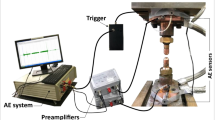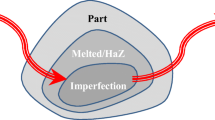Abstract
In this study, an eddy current (EC) detector is integrated in an additive/subtractive hybrid manufacturing (ASHM) process. The detector facilitates in-process inspection and repair operations through material deposition, defect detection, and removal processes layer by layer. A feasibility test is carried out on eddy current detection of subsurface defects in additively manufactured parts by using an EC detector. The study compares the results obtained from the EC detection with those by the X-ray computed tomography and the destructive methods. Experiments and simulations are conducted to investigate the effect of excitation frequency on intensity of the eddy current signal. The effects of residual heat of an additively manufactured specimen and lift-off distance of an EC probe on impedance changes are also investigated. In addition, the effect of defect width on EC signal is analyzed. The study shows that the EC method is capable of detecting subsurface defects in the ASHM parts. It is promising to integrate the EC detection and subtractive manufacturing into additive manufacturing to produce parts with improved quality and better performances.
Similar content being viewed by others
References
Delgado J, Ciurana J, Rodríguez CA (2012) Influence of process parameters on part quality and mechanical properties for DMLS and SLM with iron-based materials. Int J Adv Manuf Technol 60(5–8):601–610. https://doi.org/10.1007/s00170-011-3643-5
Wang XC, Laoui T, Bonse J, Kruth JP, Lauwers B, Froyen L (2002) Direct selective laser sintering of hard metal powders: experimental study and simulation. Int J Adv Manuf Technol 19(5):351–357. https://doi.org/10.1007/s001700200024
Boschetto A, Giordano V, Veniali F (2013) Surface roughness prediction in fused deposition modelling by neural networks. Int J Adv Manuf Technol 67(9–12):2727–2742. https://doi.org/10.1007/s00170-012-4687-x
Bikas H, Stavropoulos P, Chryssolouris G (2016) Additive manufacturing methods and modelling approaches: a critical review. Int J Adv Manuf Technol 83(1–4):389–405. https://doi.org/10.1007/s00170-015-7576-2
Gorunov AI, Gilmutdinov AK (2016) Study of the effect of heat treatment on the structure and properties of the specimens obtained by the method of direct metal deposition. Int J Adv Manuf Technol 86(9–12):2567–2574. https://doi.org/10.1007/s00170-016-8405-y
Terrazas CA, Gaytan SM, Rodriguez E, Espalin D, Murr LE, Medina F, Wicker RB (2014) Multi-material metallic structure fabrication using electron beam melting. Int J Adv Manuf Technol 71(1–4):33–45. https://doi.org/10.1007/s00170-013-5449-0
Du W, Bai Q, Zhang B (2016) A novel method for additive/subtractive hybrid manufacturing of metallic parts. Procedia Manuf 5:1018–1030. https://doi.org/10.1016/j.promfg.2016.08.067
Song YA, Park S, Choi D, Jee H (2005) 3D welding and milling: part I–a direct approach for freeform fabrication of metallic prototypes. Int J Mach Tools Manuf 45(9):1057–1062. https://doi.org/10.1016/j.ijmachtools.2004.11.021
Xiong XH, Zhang HO, Wang GL, Wang GX (2010) Hybrid plasma deposition and milling for an aeroengine double helix integral impeller made of superalloy. Robot Comput Integr Manuf 26(4):291–295. https://doi.org/10.1016/j.rcim.2009.10.002
Choi DS, Lee SH, Shin BS, Whang KH, Song YA, Park SH, Jee HS (2001) Development of a direct metal freeform fabrication technique using CO2 laser welding and milling technology. J Mater Process Technol 113(1–3):273–279. https://doi.org/10.1016/S0924-0136(01)00652-5
Ye ZP, Zhang ZJ, Jin X, Xiao MZ, Su JZ (2016) Study of hybrid additive manufacturing based on pulse laser wire depositing and milling. Int J Adv Manuf Technol 88(5):2237–2248. https://doi.org/10.1007/s00170-016-8894-8
Abe S, Higashi Y, Fuwa I, Yoshida N, YoneyamaT (2007) Milling combined laser metal sintering system and production of injection molds with sophisticated functions. Towards Synth Micro−/Nano-System, the 11th International Conference on Precision Engineering (ICPE): 285–290. https://doi.org/10.1007/1-84628-559-3_49
Aziz MSA, Ueda T, Furumoto T, Abe S, Hosokawa A, Yassin A (2012) Study on machinability of laser sintered materials fabricated by layered manufacturing system: influence of different hardness of sintered materials. Procedia CIRP 4:79–83. https://doi.org/10.1016/j.procir.2012.10.015
Doubenskaia M, Pavlov M, Chivel Y (2010) Optical system for on-line monitoring and temperature control in selective laser melting technology. Key Eng Mater 437:458–461. https://doi.org/10.4028/www.scientific.net/KEM.437.458
Clijsters S, Craeghs T, Buls S, Kempen K, Kruth JP (2014) In situ quality control of the selective laser melting process using a high-speed, real-time melt pool monitoring system. Int J Adv Manuf Technol 75(5–8):1089–1101. https://doi.org/10.1007/s00170-014-6214-8
Wang L, Felicelli SD, Craig JE (2007) Thermal modeling and experimental validation in the LENS™ process. 18th Solid Freeform Fabrication Symposium. Austin, TX: 100–111
Kanko JA, Sibley AP, Fraser JM (2016) In situ morphology-based defect detection of selective laser melting through inline coherent imaging. J Mater Process Technol 231:488–500. https://doi.org/10.1016/j.jmatprotec.2015.12.024
Smith RJ, Hirsch M, Patel R, Li WQ, Clare AT, Sharples SD (2016) Spatially resolved acoustic spectroscopy for selective laser melting. J Mater Process Technol 236:93–102. https://doi.org/10.1016/j.jmatprotec.2016.05.005
Ziolkowski G, Chlebus E, Szymczyk P, Kurzac J (2014) Application of X-ray CT method for discontinuity and porosity detection in 316L stainless steel parts produced with SLM technology. Arch Civ Mech Eng 14(4):608–614. https://doi.org/10.1016/j.acme.2014.02.003
Rieder H, Dillhofer A, Spies M, Bamberg J, Hess T (2015) Ultrasonic online monitoring of additive manufacturing processes based on selective laser melting. AIP Conf Proc 1650(1):184–191. https://doi.org/10.1063/1.4914609
Cerniglia D, Scafidi M, Pantano A, Rudlin J (2015) Inspection of additive-manufactured layered components. Ultrasonics 62:292–298. https://doi.org/10.1016/j.ultras.2015.06.001
Karthik N V, Gu H, Pal D, Starr T, Stucker B (2013) High frequency ultrasonic non-destructive evaluation of additively manufactured components. 24th International Solid Freeform Fabrication Symposium: 311–325
Blodgett MP, Nagy PB (2004) Eddy current assessment of near-surface residual stress in shot-peened nickel-base superalloys. J Nondestruct Eval 23(3):107–123. https://doi.org/10.1023/B:JONE.0000048866.40648.fe
Nagendran R, Thirumurugan N, Chinnasamy N, Janawadkar MP, Baskaran R, Vaidhyanathan LS, Sundar CS (2010) Optimum eddy current excitation frequency for subsurface defect detection in SQUID based non-destructive evaluation. NDT E Int 43(8):713–717. https://doi.org/10.1016/j.ndteint.2010.08.003
Park DG, Angani CS, Rao BPC, Vertesy G, Lee DH, Kim KH (2013) Detection of the subsurface cracks in a stainless steel plate using pulsed Eddy current. J Nondestruct Eval 32(4):350–353. https://doi.org/10.1007/s10921-013-0188-6
Tian GY, Sophian A, Taylor D, Rudlin J (2005) Multiple sensors on pulsed eddy-current detection for 3-D subsurface crack assessment. IEEE Sensors J 5(1):90–96. https://doi.org/10.1109/JSEN.2004.839129
Arjun V, Sasi B, Rao BPC, Mukhopadhyay CK, Jayakumar T (2015) Optimisation of pulsed eddy current probe for detection of sub-surface defects in stainless steel plates. Sensor Actuators A Phys 226:69–75. https://doi.org/10.1016/j.sna.2015.02.018
Javier GM, Jaime GG, Ernesto VS (2011) Non-destructive techniques based on Eddy current testing. Sensors 11(12):2525–2565
Hughes R, Fan Y, Dixon S (2014) Near electrical resonance signal enhancement (NERSE) in eddy-current crack detection. NDT E Int 66:82–89. https://doi.org/10.1016/j.ndteint.2014.04.009
Schwerdtfeger J, Singer RE, Korner C (2012) In situ flaw detection by IR-imaging during electron beam melting. Rapid Prototyp J 18(4):259–263. https://doi.org/10.1108/13552541211231572
Jain A, Sheth N V, Lal C N (2015) Inspection of laser welded hermitically sealed packages using eddy current flaw detection method. Computer, communication and control (IC4), international conference on. IEEE : 1–5
Mook G, Hesse O, Uchanin V (2007) Deep penetrating eddy currents and probes. Mater Test 49(5):258–264. https://doi.org/10.3139/120.100810
Mao XF, Lei YZ (2016) Thickness measurement of metal pipe using swept-frequency eddy current testing. NDT E Int 78:10–19. https://doi.org/10.1016/j.ndteint.2015.11.001
Li Y, Sheng XJ, Lian M, Wang YQ (2016) Influence of tilt angle on eddy current displacement measurement. Nondestruct Test Eval 31(4):289–302. https://doi.org/10.1080/10589759.2015.1081905
Janousek L, Chen Z, Yusa N, Miya K (2005) Excitation with phase shifted fields-enhancing evaluation of deep cracks in eddy-current testing. NDT E Int 38(6):508–515. https://doi.org/10.1016/j.ndteint.2005.01.012
Qian L, Mei J, Liang J, Wu X (2005) Influence of position and laser power on thermal history and microstructure of direct laser fabricated Ti–6Al–4V samples. Mater Sci Technol Lond 21(5):597–605. https://doi.org/10.1179/174328405X21003
Amine T, Newkirk JW, Liou F (2014) Numerical simulation of the thermal history multiple laser deposited layers. Int J Adv Manuf Technol 73(9–12):1625–1631. https://doi.org/10.1007/s00170-014-5961-x
Vertesy G, Uchimoto T, Tomas I, Takagi T (2010) Temperature dependence of magnetic descriptors of magnetic adaptive testing. IEEE T Magn 46(2):509–512. https://doi.org/10.1109/TMAG.2009.2033455
Theodoulidis T (2010) Developments in efficiently modelling eddy current testing of narrow cracks. NDT E Int 43(7):591–598. https://doi.org/10.1016/j.ndteint.2010.06.003
Christophe A, Le Bihan Y, Rapetti F (2015) A mortar element approach on overlapping non-nested grids: application to eddy current non-destructive testing. Appl Math Comput 267:71–82. https://doi.org/10.1016/j.amc.2015.05.126
Zhang B, Li YT, Bai Q (2017) Defect formation mechanisms in selective laser melting: areview. Chin J Mech Eng 30(3):1–13. https://doi.org/10.1007/s10033-017-0121-5
Takagi T, Huang H, Fukutomi H, Tani J (1998) Numerical evaluation of correlation between crack size and eddy current testing signal by a very fast simulator. IEEE T Magn 34(5):2581–2584. https://doi.org/10.1109/20.717596
Acknowledgments
The financial supports from the Science Challenge Project (JCKY2016212A506-0101), the National Natural Science Foundation of China (51605077), and the Science Fund for Creative Research Groups of NSFC (51621064) are gratefully acknowledged.
Author information
Authors and Affiliations
Corresponding author
Rights and permissions
About this article
Cite this article
Du, W., Bai, Q., Wang, Y. et al. Eddy current detection of subsurface defects for additive/subtractive hybrid manufacturing. Int J Adv Manuf Technol 95, 3185–3195 (2018). https://doi.org/10.1007/s00170-017-1354-2
Received:
Accepted:
Published:
Issue Date:
DOI: https://doi.org/10.1007/s00170-017-1354-2




